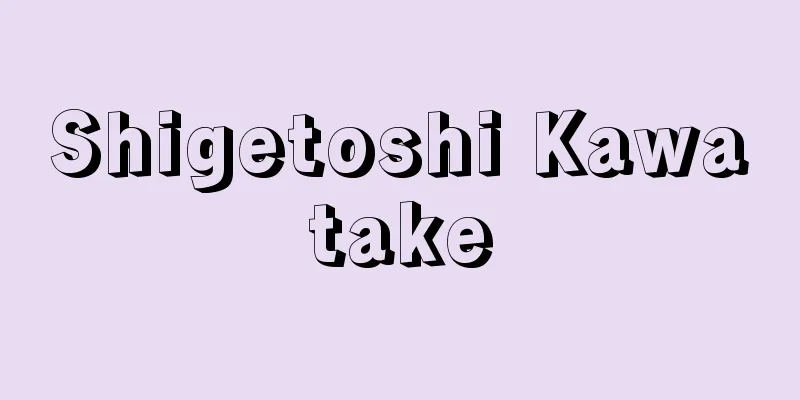Over the counter market

|
This refers to the form in which securities such as stocks and bonds are traded in places other than a stock exchange (for example, over the counter at a securities company). Generally speaking, while exchange transactions are conducted in a highly organized, concrete market, the over-the-counter market is considered an abstract market because it is traded over the counter. It is also called the OTC market, taking its English acronym. [Gen Takahashi December 14, 2015] Market before and after World War IIIn Japan, stock trading at stock exchanges had been suspended since August 10, 1945 (Showa 20), just before the end of World War II. After the war, there was a strong demand in the securities industry for the market to be reopened, but on September 26 of the same year, a memorandum from the General Headquarters of the Supreme Commander for the Allied Powers (GHQ) postponed the reopening indefinitely. However, as the postwar economic recovery progressed, companies began to seek a place to raise funds in the securities market, and the need for securities trading also increased among investors. As a result, a form in which securities company trading staff spontaneously gathered at a certain location to trade stocks became widespread. This was called "collective trading" and became the basis of the over-the-counter stock market. The Securities and Exchange Act was enacted in 1947, and the Tokyo Stock Exchange (TSE) was established in April 1949. Trading resumed in May, and stock trading began. However, the "over-the-counter trading approved stock system" was established in June of the same year as a place to buy and sell stocks that were not listed at that time. This was also intended to foster unlisted companies and provide a place for small and medium-sized enterprises to raise funds. Due to its origins, the over-the-counter market was operated under the management of the Japan Securities Dealers Association. However, in the 1960s, the over-the-counter market had grown to become the third largest after the Tokyo Stock Exchange and the Osaka Securities Exchange (now the Osaka Exchange), and after a review by the Securities and Exchange Council (SEX Council), it was determined that organized collective trading could violate the "prohibition on the establishment of market-like facilities" in the Securities and Exchange Act (now the Financial Instruments and Exchange Act), and issued a recommendation to establish a "Second Section" that would absorb over-the-counter approved stocks. In response to this, in October 1961, the Second Sections of the Tokyo, Osaka, and Nagoya stock exchanges were established, and at the same time the system of over-the-counter approved stocks was abolished. [Gen Takahashi December 14, 2015] Over-the-counter stock registration systemEven after the Second Section was launched, the rapid economic growth once again led to small and medium-sized unlisted companies seeking financing in the over-the-counter market, so the Japan Securities Dealers Association established the "Over-the-Counter Traded Stock Registration System" in February 1963. In June 1976, 187 securities companies from around the country invested in Japan Over-the-Counter Securities Co., Ltd., a company specializing in intermediation, to establish rules for trading in the over-the-counter market. After that, in response to recommendations from the Securities and Exchange Council for relaxing the standards for public offerings, expanding the functions of the primary market, and thorough information disclosure, the so-called "New Over-the-Counter Market" was launched in November 1983. In the New Over-the-Counter Market, the JASDAQ system went into operation in 1991. Furthermore, following the financial reforms of 1998, Japan Over-the-Counter Securities Co., Ltd. changed its name to Jasdaq Services Co., Ltd. and continued to operate the over-the-counter market, but in December 2004, the company was rebranded as the Jasdaq Securities Exchange. Jasdaq Securities Exchange also established a new market for venture companies called "NEO" (short for New Entrepreneurs ' Opportunity ) in August 2007. In the midst of this, the Osaka Securities Exchange made Jasdaq Securities Exchange a subsidiary through a tender offer in December 2008 (and made it a wholly owned subsidiary in September 2009), and there were moves toward market reorganization and integration. In October 2010, the "JASDAQ" and "NEO" markets operated by Jasdaq Securities Exchange and the "Hercules" market operated by the Osaka Securities Exchange were integrated to form the "New JASDAQ Market" under the Osaka Securities Exchange. Furthermore, following the merger of the Tokyo Stock Exchange and the Osaka Stock Exchange, the JASDAQ market has been managed by the Tokyo Stock Exchange since July 2013. The name JASDAQ was modeled after the American over-the-counter market, NASDAQ. [Gen Takahashi December 14, 2015] Dot-com MarketIncidentally, in the 1990s, when the Internet began to spread, stocks of Internet-related companies led the market on the NASDAQ in the United States. These stocks were called "dot com stocks" because many of the company names ended with ".com" on the Internet, and the market situation or market in which dot com stocks led was called the dot com market. Even today, dot com stocks are a major presence not only in NASDAQ but also in emerging stock markets around the world, including Japan. However, since many of these stocks are new and have little historical track record, while they have the potential for rapid growth, they also have unstable aspects in terms of their financial structure and performance. For this reason, the fluctuations in stock prices are large, and there have been times in the past when the trends of the dot com market have influenced the stock price direction of the entire stock market, strengthening their influence. In the past, the over-the-counter market was positioned as a complementary role to the listed market, but today it has transformed into an entity that competes with various financial markets, including the listed market. [Gen Takahashi December 14, 2015] [Reference items] | | | | | | |Source: Shogakukan Encyclopedia Nipponica About Encyclopedia Nipponica Information | Legend |
|
株式や債券などの有価証券が、証券取引所以外の場所(たとえば証券会社の店頭)で取引されている形態をいう。一般に、取引所取引が高度に組織化された具体的市場で行われるのに対して、店頭市場は相対(あいたい)取引であるため抽象的市場ととらえられる。英語の頭文字をとってOTC市場ともよばれる。 [高橋 元 2015年12月14日] 第二次世界大戦前後の市場日本の株式流通市場は、第二次世界大戦終戦直前の1945年(昭和20)8月10日以降、証券取引所での取引は停止されていた。戦後、証券界では市場再開を求める声が強かったものの、同年9月26日の連合国最高司令官総司令部(GHQ)の覚書によって無期延期とされた。しかし、戦後の経済復興が進むにつれて、企業は証券市場に資金調達の場を求めるようになり、投資家の間にも証券売買のニーズが高まっていった。そこで、証券会社の売買担当者が自然発生的に一定の場所に集まって株式取引を行う形態が普及していった。これは「集団売買」とよばれ、株式店頭市場の基礎となった。1947年に証券取引法が成立し、1949年4月には東京証券取引所(東証)が設立、5月には取引が再開され株式売買が開始されたが、このとき上場されなかった銘柄などを売買する場として、同年6月以降は「店頭売買承認銘柄制度」が創設された。これには、非上場会社を育成し、中小企業にも資金調達の場を提供しようという意図もあった。店頭市場は発生からの経緯もあり、日本証券業協会の管理の下で運営された。しかし、1960年代に入ると、店頭市場は東証、大阪証券取引所(大証。現、大阪取引所)に次ぐ規模にまで成長し、証券取引審議会(証取審)で検討した結果、組織化された集団売買は証券取引法(現、金融商品取引法)の「市場類似施設開設の禁止」に抵触するおそれがあるとして、店頭承認銘柄を吸収した「市場第二部」設置の答申が出された。これを受けて1961年10月に東京、大阪、名古屋の3証券取引所で市場第二部が創設され、同時に店頭売買承認銘柄制度は廃止された。 [高橋 元 2015年12月14日] 店頭売買銘柄登録制度市場第二部が発足してからも、経済の高度成長に伴い中小規模の未公開企業が資金調達を店頭市場に求める動きがふたたび活発化したため、日本証券業協会は1963年2月に「店頭売買銘柄登録制度」を設けた。また、1976年6月には、店頭市場における売買ルールの整備を図ることなどを目的に、全国の証券187社が出資して、仲介専門の日本店頭証券株式会社が設立された。その後、証取審から、株式公開基準の緩和、発行市場機能の拡充、情報開示の徹底などが提言されたことを受けて、1983年11月にいわゆる「新店頭市場」が発足した。新店頭市場では、1991年(平成3)にJASDAQ(ジャスダック)システムが稼動した。さらに、1998年の金融制度改革に伴い、日本店頭証券株式会社は株式会社ジャスダック・サービスへと商号変更され、引き続き店頭市場の運営を担ったが、同社は2004年(平成16)12月にジャスダック証券取引所に衣替えした。また、ジャスダック証券取引所は2007年8月にベンチャー企業向けの新市場「NEO(ネオ)」(New Entrepreneurs' Opportunityの略)を創設した。そうしたなか、2008年12月には、大証が株式公開買付によりジャスダック証券取引所を子会社化(2009年9月には完全子会社化)するなど、市場の再編・統合へ向けた動きが進展した。2010年10月には、それまでジャスダック証券取引所が開設していた「JASDAQ」「NEO」と、大証が開設していた「ヘラクレス」が統合され、大証傘下の「新JASDAQ市場」が発足した。さらに、東証と大証の経営統合に伴い、2013年7月以降JASDAQ市場は東証により管理されることとなった。なお、ジャスダック(JASDAQ)という呼称は、アメリカの店頭市場であるNASDAQ(ナスダック)に倣ったものである。 [高橋 元 2015年12月14日] ドット・コム市場ちなみに、アメリカのNASDAQではインターネットが普及し始めた1990年代に、インターネット関連企業の株が相場を牽引(けんいん)した。これらの銘柄はインターネット上のアドレスが「~.com」で終わる社名が多かったことから「ドット・コム株dot com stock」とよばれ、ドット・コム株がリードする相場局面あるいは市場はドット・コム市場とよばれた。今日でも、NASDAQだけでなく日本を含む世界の新興株式市場において、ドット・コム株は主要な存在となっている。しかし、これらの銘柄は創業が新しく歴史的な実績に乏しい企業が多いため、急成長する可能性がある一方、財務体質や業績などで不安定な面がある。それだけに株価の変動振幅も大きく、これまでにもドット・コム市場の動向が株式市場全体の株価方向性を左右するなど、影響力を強める場面がみられた。かつて店頭市場は上場市場の補完的な役割と位置づけられていたが、今日では上場市場を含む多様な金融市場との間で競争を展開する存在へと変質を遂げている。 [高橋 元 2015年12月14日] [参照項目] | | | | | | |出典 小学館 日本大百科全書(ニッポニカ)日本大百科全書(ニッポニカ)について 情報 | 凡例 |
Recommend
Cart
...A menu for a meal in which the types and order...
Sadafumi Taira - Sadafumi Taira
Year of death: 27 September 1, Chosen (8 November ...
Kounomai mine
A gold and silver mine located in northeastern Hok...
Solid sintering
...However, when the powder contains two or more ...
Archangel Cathedral - Archangel Cathedral
...The Kremlin took on the form we see today betw...
Art Theatre
(1) Name of the theater company. Founded in 1913 ...
Viola, W.
From an artistic point of view, what is required ...
Cachexia
Among tumors, those called malignant tumors are c...
Djenné
An ancient city in southern Mali. A key trade poin...
Water chestnut (Sagittaria trifolia var. sinensis)
A perennial plant of the Albataceae family. It is ...
crow
…A small number of ravens (C. corax) migrate to H...
Tentara Pembela Tanah Air (English)
...The Indonesian military force trained by the J...
Ou-yang Tong (English spelling)
[raw]? [Death] Tenju 2 (691) A calligrapher from t...
Yangzhou
A prefecture-level city located in the south-cent...
Sweet potato
...With his unique writing style that goes one st...








![Niisato [village] - Niisato](/upload/images/67cc6afa4f011.webp)
